How To Get Involved In Political Activism For Animal Rights
8.1 What Is Political Participation?
Learning Objectives
Afterwards reading this section, yous should be able to answer the post-obit questions:
- What are the ways in which Americans participate in politics?
- What factors influence voter turnout in elections?
- How do Americans participate in groups?
Americans have many options for taking part in politics, including voting, contacting public officials, campaigning, running for and holding office, protesting, and volunteering. Voting is the nigh prominent course of political participation. Voter registration and turnout is influenced by legal and structural factors, voter qualifications, the type of election, and voters' enthusiasm about a item campaign.
Types of Political Participation
Political participation is action that influences the distribution of social goods and values (Rosenstone & Hansen, 1993). People tin can vote for representatives, who make policies that will determine how much they have to pay in taxes and who will do good from social programs. They can take part in organizations that work to directly influence policies made by government officials. They tin can communicate their interests, preferences, and needs to regime by engaging in public fence (Verba, Schlozman, & Brady, 1995). Such political activities tin support regime officials, institutions, and policies, or aim to change them.
Far more people participate in politics past voting than past whatsoever other means. Yet there are many other ways to take function in politics that involve varying amounts of skill, time, and resources. People can work in an election campaign, contact public officials, circulate a petition, join a political organization, and donate money to a candidate or a cause. Serving on a local governing or school board, volunteering in the customs, and running for part are forms of participation that crave significant fourth dimension and energy. Organizing a sit-in, protesting, and even rioting are other forms of participation (Milbrath & Goel, 1977).
People likewise tin can take office in support activities, more passive forms of political involvement. They may attend concerts or participate in sporting events associated with causes, such equally the "Race for the Cure" for breast cancer. These events are designed to raise money and awareness of societal problems, such as poverty and health intendance. However, almost participants are not activists for these causes. Support activities tin lead to active participation, every bit people learn most bug through these events and decide to become involved.
Figure 8.i
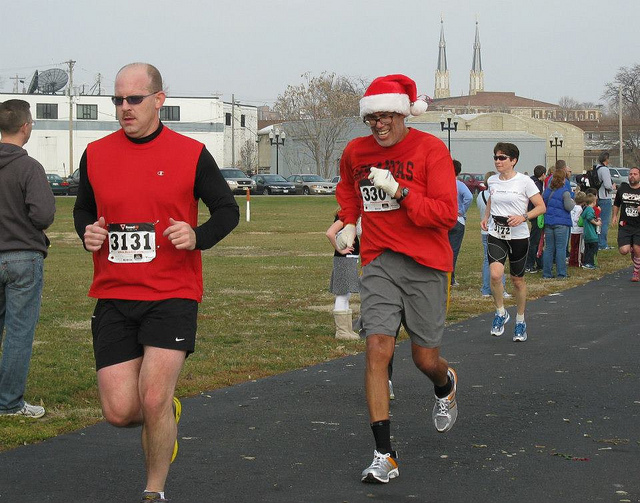
People take role in support activities on behalf of a cause, which can lead to greater involvement.
People also tin can engage in symbolic participation, routine or habitual acts that show support for the political system. People salute the flag and recite the pledge of fidelity at the showtime of a schoolhouse twenty-four hour period, and they sing the national anthem at sporting events. Symbolic acts are not always supportive of the political arrangement. Some people may refuse to say the pledge of fidelity to express their dissatisfaction with government. Citizens can prove their unhappiness with leadership choices past the symbolic act of non voting.
Voting
For many people, voting is the principal means of taking part in politics. A unique and special political human action, voting allows for the views of more people to exist represented than any other action. Every citizen gets ane vote that counts as. Over 90 percentage of Americans concur with the principle that citizens have a duty to vote (Flanigan & Zingale, 1999). Still, many people do not vote regularly.
Voter Qualifications
Registered voters meet eligibility requirements and have filed the necessary paperwork that permits them to vote in a given locality. In improver to the requirement that voters must exist 18 years of age, states tin enforce residency requirements that mandate the number of years a person must live in a place before existence eligible to vote. A big bulk of people who accept registered to vote participate in presidential elections.
The composition of the electorate has changed radically throughout American history. The puddle of eligible voters has expanded from primarily white, male belongings owners at the founding to include black men later on the Civil War, women after 1920, and xviii- to twenty-year-olds afterwards 1971. The eligible electorate in the 1800s, when voter turnout consistently exceeded lxx percent, was far dissimilar than the diverse pool of eligible voters today.
Barriers to Voting
Social, cultural, and economic factors can go along people from voting. Some barriers to voting are informal. The United States holds a large number of elections, and each is governed past specific rules and schedules. With and so many elections, people can get overwhelmed, confused, or only plain tired of voting.
Other barriers are structural. Voter registration laws were implemented in the 1860s by states and big cities to ensure that just citizens who met legal requirements could vote. Residency requirements limited admission to registration offices. Closing voting rosters weeks or months in accelerate of elections finer disenfranchised voters. Over fourth dimension, residency requirements were relaxed. Get-go in the 1980s, some states, including Maine, Minnesota, and Wisconsin, made it possible for people to register on Ballot Day. Turnout in states that have Election Day registration averages x points higher than in the rest of the country (Wolfinger & Rosenstone, 1980).
The United States is one of the few democracies that requires citizens to register themselves rather than having the government take responsibility for automatically registering them. Meaning steps have been taken to make registration easier. In 1993, Congress passed the National Voter Registration Human activity, also known as the "motor voter" law, allowing citizens to register at motor vehicle and social service offices. "Motor voter'due south" success in increasing the ranks of registered voters differs by land depending on how well the program is publicized and executed.
Effigy viii.ii
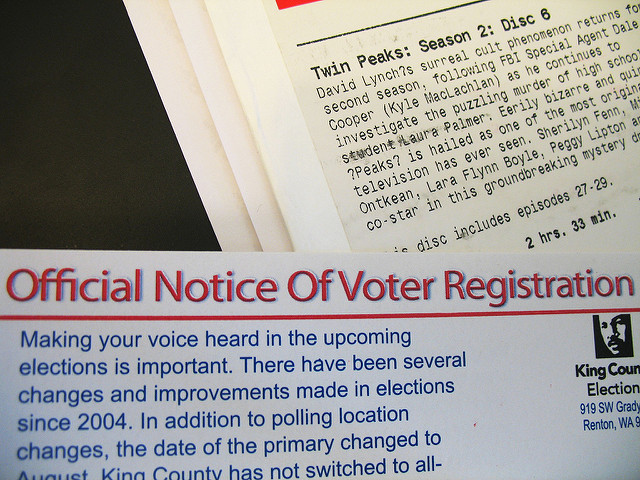
Organizations conducting voter registration drives register as many voters as government voter registration sites.
Voter registration also has been assisted by online registration. In most cases, individuals must download the form, sign it, and mail information technology in. Rock the Vote (RTV), a nonpartisan youth mobilization organization, established the first online voter registration initiative in 1992 with official bankroll from the Congressional Internet Conclave. RTV registered over 2 million new voters in 1992, 80 per centum of whom bandage a election, and signed up over 2.5 million voters in 2008.[1] Post-obit the 2008 election, RTV lobbied the Obama administration to establish fully automated online voter registration nationally.
Disenfranchisement of Felons
In all states except Maine, Vermont, and Massachusetts, inmates serving fourth dimension for committing felonies lose their right to vote. At least 10 states prohibit erstwhile felons from voting even afterwards they have served their time. States fence that their legal authority to deny convicted felons voting rights derives from the Fourteenth Subpoena, which stipulates that voting rights of individuals guilty of "participation in rebellion, or other crime" tin be denied. This practice excludes near 4 million people from the voting rolls (Man Rights Watch and the Sentencing Project, 2000).
Opinions are divided on this issue. Some people believe that individuals who have committed a serious crime should be deprived of the privileges enjoyed by police-abiding people. Others contend that the integrity of the democratic procedure is at stake and that individuals should not exist denied a primal right once they have served their fourth dimension.
Turnout
Voter turnout depends on the type of election. A large number of elections are held in the United States every yr, including local elections, elections for county and statewide offices, primaries, and general elections. But a small number of people, generally under one-quarter of those eligible, participate in local, county, and country elections. Midterm elections, in which members of Congress run for office in nonpresidential-election years, ordinarily draw most one-3rd of eligible voters (Rosenstone & Hansen, 1993). Voter turnout in presidential elections is generally higher than for lower-level contests; ordinarily more than one-half the eligible voters cast a ballot.
Much is fabricated virtually depression levels of voter turnout for presidential elections in the current era. All the same, in that location have not been bang-up fluctuations in turnout since the institution of universal suffrage in 1920. Twoscore-nine percent of the voting-age public cast a ballot in the 1924 presidential competition, the same pct as in 1996. Turnout in presidential elections in the 1960s was over lx percent. More voters were mobilized during this period of political upheaval in which people focused on issues of race relations, social welfare, and the Vietnam State of war (Piven & Cloward, 2000). Turnout was lower in the 1980s and 1990s, when the political climate was less tumultuous. There has been a steady increase in turnout since the 2000 presidential ballot, in which 51 percent of the voting-age public cast a election. Turnout was 55 percent in 2004 and 57 percentage in 2008, when 132,618,580 people went to the polls (McDonald).
Turnout varies significantly across localities. Some regions have an established culture of political participation. Local elections in small towns in New England describe upwards to 80 percent of qualified voters. Over 70 pct of Minnesota voters cast ballots in the 2008 presidential election compared with 51 percent in Hawaii and Due west Virginia (McDonald).
Turnout figures can exist skewed past undercounting the vote. This trouble gained attention during the 2000 election. The contested vote in the Florida presidential race resulted in a recount in several counties. Ballots can be invalidated if they are not properly marked by voters or are not read past antiquated voting machines. Political scientists take determined that presidential election turnout is underestimated on boilerplate by 4 percent, which translates into hundreds of thousands of votes (Flanigan & Zingale, 1999).
Voters in midterm elections choose all the members of the US House of Representatives and i-third of the Senate, forth with office holders at the state and local levels. Voter turnout levels accept hovered effectually 40 percent in the past 3 midterm elections. Turnout for the 2010 midterm election was 41.6 percent, compared with 41.4 per centum in 2006 and 40.five pct in 2002 (McDonald). Young voters are less likely to plow out in midterm elections than older citizens. In 2010, only virtually 23 pct of eligible eighteen- to twenty-nine-twelvemonth-olds cast a ballot (Heart for Information & Research on Borough Learning and Engagement). The The states Election Projection provides information about voter turnout in presidential campaigns.
Autonomous Participation
People take many options for engaging in politics. People tin can act alone by writing letters to members of Congress or staging acts of civil disobedience. Some political activities, such as boycotts and protestation movements, involve many people working together to attract the attention of public officials. Increasingly people are participating in politics via the media, especially the Internet.
Contacting Public Officials
Expressing opinions about leaders, bug, and policies has become ane of the most prominent forms of political participation. The number of people contacting public officials at all levels of authorities has risen markedly over the by iii decades. Seventeen percent of Americans contacted a public official in 1976. By 2008, 44 percent of the public had contacted their member of Congress about an issue or concern (Congressional Management Foundation, 2008). Electronic mail has made contacting public officials cheaper and easier than the traditional method of mailing a letter.
Figure 8.3
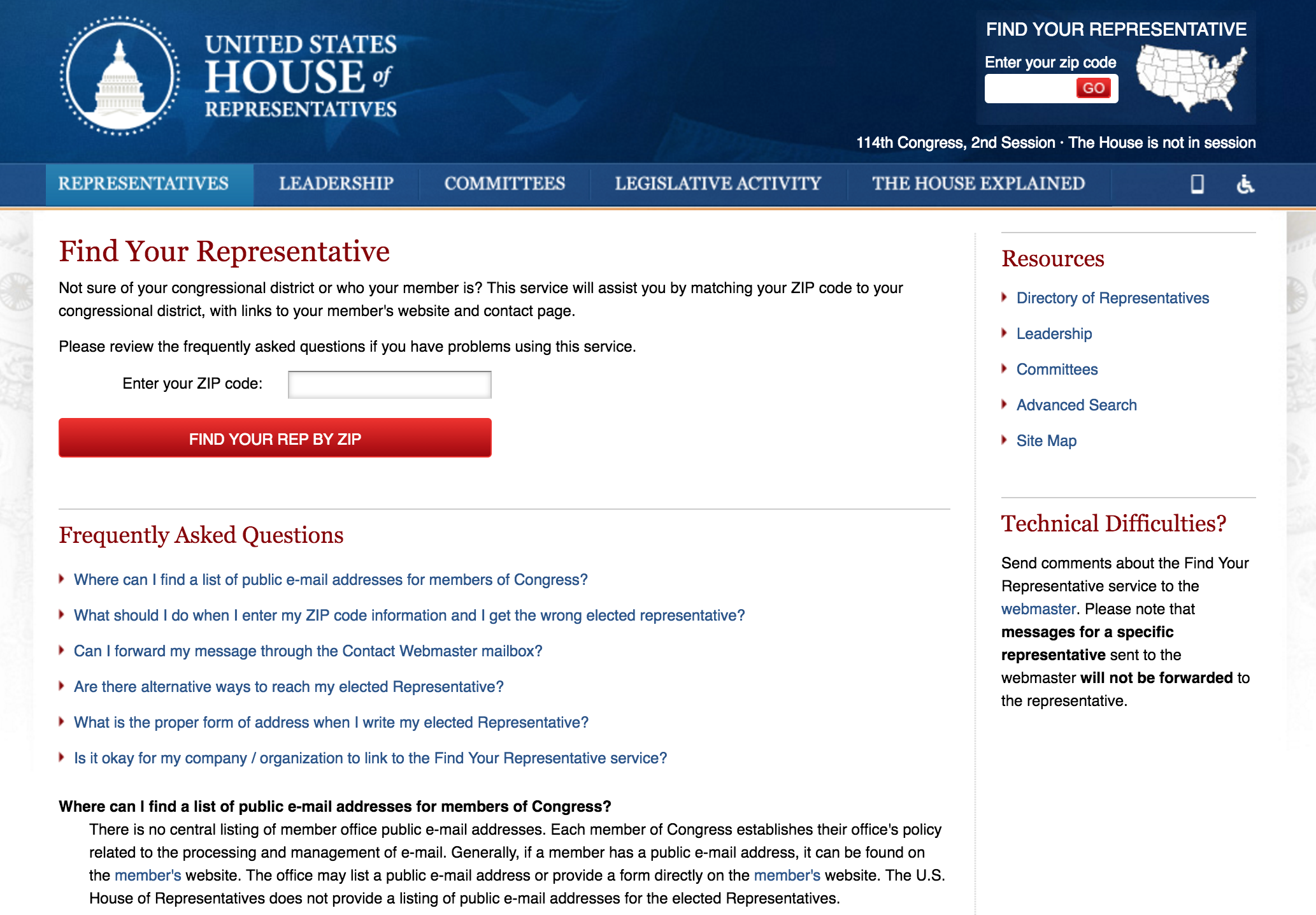
The directive to "write your member of Congress" is taken seriously by increasing numbers of citizens: legislators' east-postal service boxes are filled daily, and millions of letters are processed by the Capitol Hill mail offices.
Students interning for public officials soon learn that answering constituent postal service is ane of the well-nigh time-consuming staff jobs. Every day, millions of people voice their opinions to members of Congress. The Senate alone receives an average of over iv meg due east-postal service letters per week and more two hundred million east-mail messages per yr (Congressional Direction Foundation, 2008). Still, e-mail may not be the most effective way of getting a message beyond because office holders believe that an e-mail message takes less fourth dimension, endeavor, and thought than a traditional letter. Leaders frequently are "spammed" with mass eastward-mails that are not from their constituents. Letters and phone calls nigh ever receive some kind of a response from members of Congress.
Contributing Money
Effigy 8.4

Direct mail appeals by single-event groups for contributions aimed especially at more affluent Americans are targeted methods of mobilizing people.
The number of people who give money to a candidate, party, or political organisation has increased substantially since the 1960s. Over 25 per centum of the public gave coin to a cause and 17 percent contributed to a presidential candidate in 2008 (Pew Research Eye for the People and the Printing, 2008). Direct mail and e-mail solicitations make fundraising easier, especially when donors can contribute through candidate and political-party websites. A positive side effect of fundraising campaigns is that people are made aware of candidates and problems through appeals for money (Jacobson, 1997).
Americans are more likely to make a financial contribution to a crusade or a candidate than to donate their fourth dimension. As one would wait, those with college levels of education and income are the most likely to contribute. Those who give money are more than likely to proceeds access to candidates when they are in office.
Campaign Activity
In addition to voting, people engage in a range of activities during campaigns. They work for political parties or candidates, organize entrada events, and talk over issues with family unit and friends. By and large, about 15 per centum of Americans participate in these types of campaign activities in an election twelvemonth (Verba, Schlozman, & Brady, 1995).
New media offer additional opportunities for people to engage in campaigns. People tin can blog or participate in word groups related to an election. They tin can create and post videos on behalf of or opposed to candidates. They can use social networking sites, like Facebook, to recruit supporters, enlist volunteers for campaign events, or encourage friends to donate coin to a candidate.
Effigy 8.5
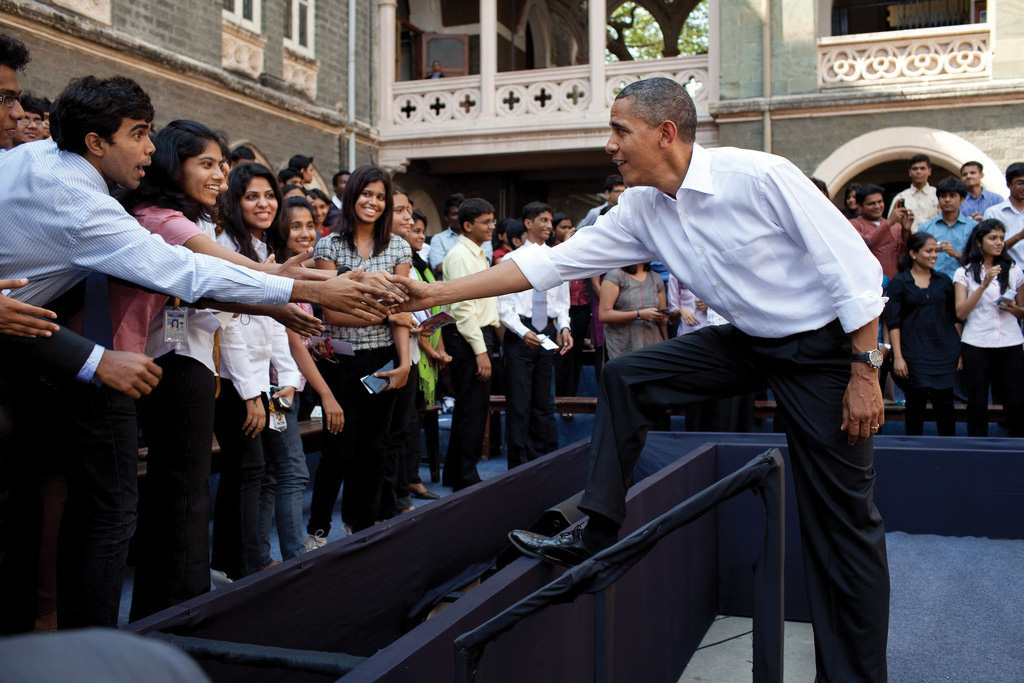
Participation in the 2008 presidential election was greater than usual, as people were motivated by the open race and the candidate choices.
The 2008 presidential election sparked high levels of public interest and engagement. The race was open, as there was no incumbent candidate, and voters felt they had an opportunity to make a difference. Democrat Barack Obama, the first African American to be nominated by a major party, generated enthusiasm, specially among young people. In improver to traditional forms of campaign activity, like attending campaign rallies and displaying yard signs, the Internet provided a gateway to involvement for 55 percent of Americans (Owen, 2009). Young people, in particular, used social media, similar Facebook, to organize online on behalf of candidates. Students advertised campus election events on social media sites, such equally candidate rallies and voter registration drives, which drew big crowds.
Running for and Holding Public Office
Being a public official requires a peachy deal of dedication, time, free energy, and money. About 3 percent of the adult population holds an elected or appointed public office (Verba, Schlozman, & Brady, 1995). Although the percentage of people running for and holding public function appears small, there are many opportunities to serve in authorities.
Potential candidates for public office must gather signatures on a petition before their names can appear on the ballot. Some people may be discouraged from running because the signature requirement seems daunting. For example, running for mayor of New York City requires 7,500 signatures and addresses on a petition. Once a candidate gets on the ballot, she must organize a campaign, solicit volunteers, raise funds, and garner press coverage.
Protest Activity
Protests involve unconventional, and sometimes unlawful, political actions that are undertaken in guild to proceeds rewards from the political and economic organization. Protest behavior can take many forms. People can engage in nonviolent acts of civil disobedience where they deliberately pause a law that they consider to be unjust (Lipsky, 1968). This tactic was used effectively during the 1960s civil rights movement when African Americans sat in whites-only sections of public busses. Other forms of protestation behavior include marker public spaces with graffiti, demonstrating, and boycotting. Extreme forms of protest behavior include acts that cause damage, such as when environmental activists place spikes in trees that tin seriously injure loggers, terrorist acts, similar bombing a edifice, and civil state of war.
Figure eight.half-dozen The Watts Riots

The Watts riots in 1965 were the first of a number of ceremonious disturbances in American cities. Although its participants thought of them as political protests, the news media presentation rarely gave that betoken of view.
Extreme discontent with a particular societal condition can lead to rioting. Riots are oft spontaneous and are sparked by an incident that brings to a caput deep-seated frustrations and emotions. Members of social movements may resort to rioting when they perceive that at that place are no conventional alternatives for getting their bulletin across. Riots can issue in devastation of belongings, looting, physical damage, and even decease. Racial tensions sparked by a video of law beating Rodney King in 1991 and the subsequent acquittal of the officers at trial resulted in the worst riots ever experienced in Los Angeles.
Comparing Coverage
The Rodney Rex Video
In March 1991, KTLA News at X in Los Angeles interrupted programming to broadcast an eighty-ane-2d amateur videotape of several law officers savagely chirapsia black motorist Rodney King every bit he stood next to his vehicle. A nineteen-2nd edit of the tape depicted the most brutal police actions and became one of the most heavily broadcast images in television news history. The original and the edited tape tell two unlike stories of the same event.
Viewing the entire tape, one would have seen a belligerent and violent Rodney King who was hard for police to constrain. Not filmed at all was an intoxicated Male monarch driving erratically, leading police on an 8-mile, high-speed chase through crowded streets.
The edited video showing the beating of King told a different story of constabulary brutality and was the basis of much controversy. Race relations in Los Angeles in 1991 were strained. The tape enraged blacks in Los Angeles who saw the police actions as being widespread within the Los Angeles Police Department and not an isolated incident.
Four white officers were tried in criminal court for the use of excessive force, and they were acquitted of all but one charge. Jurors were shown the entire tape, non only the famous nineteen-second clip. Soon after the verdict was announced, riots broke out. Demonstrators burned buildings and assaulted bystanders. Fifty-four people were killed and two grand were wounded. Property damage was in the millions of dollars.
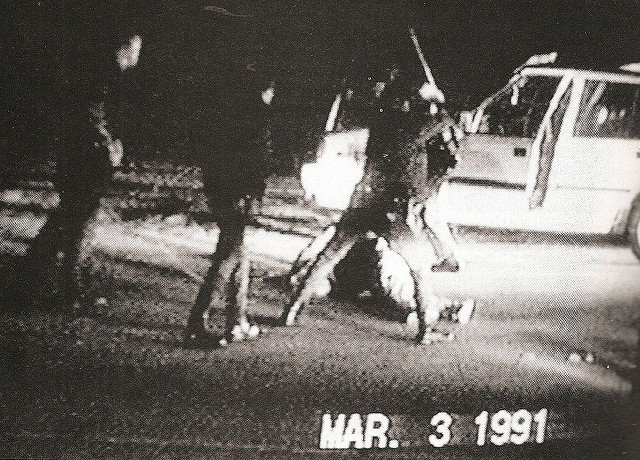
The video of the beating of Rodney King in Los Angeles in 1991 sparked riots.
Video Clip
LA Riots of 1992: Rodney King Speaks
(click to see video)
The post-obit video is the CNN News Report on the Los Angeles Riots, including Rodney Male monarch's appeal to end the violence.
Higher students in the 1960s used demonstrations to voice their opposition to the Vietnam War. Today, students demonstrate to describe attention to causes. They make use of new communications technologies to organize protests past forming groups on the Internet. Online strategies accept been used to organize demonstrations against the globalization policies of the World Trade Organization and the World Bank. Over 2 hundred websites were established to rally support for protests in Seattle, Washington; Washington, DC; Quebec City, Canada; and other locations. Protest participants received online instructions at the protestation site near travel and housing, where to assemble, and how to behave if arrested. Extensive email listservs keep protestors and sympathizers in contact between demonstrations. Twitter, a social messaging platform that allows people to provide brusk updates in real time, has been used to convey eyewitness reports of protests worldwide. Americans followed the riots surrounding the contested presidential election in Iran in 2009 on Twitter, as observers posted unfiltered, graphic details as the vehement upshot unfolded.
Participation in Groups
About one-half the population takes part in national and community political affairs by joining an interest group, result-based organization, civic organisation, or political political party. Organizations with the goal of promoting civic action on behalf of particular causes, or unmarried-issue groups, have proliferated. These groups are equally various as the People for the Upstanding Treatment of Animals (PETA), which supports animal rights, the Concord Coalition, which seeks to protect Social Security benefits, and the Aryan Nation, which promotes white supremacy.
There are many means to advocate for a crusade. Members may engage in lobbying efforts and take part in demonstrations to publicize their concerns. They tin post their views on blogs and energize their supporters using Facebook groups that provide information near how to get involved. Up to 70 percent of members of single-result groups show their support solely by making monetary contributions (Putnam, 2000).
Volunteering
Fifty-fifty activities that on the surface do not seem to take much to practise with politics can be a form of political participation. Many people take function in neighborhood, schoolhouse, and religious associations. They act to benefit their communities without monetary compensation.
Peradventure you coach a little league squad, visit seniors at a nursing home, or piece of work at a homeless shelter. If so, you are taking office in civil society, the community of individuals who volunteer and work cooperatively outside of formal governmental institutions (Eberly, 1998). Ceremonious society depends on social networks, based on trust and goodwill, that form between friends and associates and allow them to work together to attain common goals. Community activism is thriving amongst immature people who realize the importance of service that direct assists others. Well-nigh 70 percent of high school students and immature adults aged 18 to xxx report that they have been involved in community activities (Peter D. Hart Research Assembly, 1998).
Key Takeaways
In that location are many unlike ways that Americans can participate in politics, including voting, joining political parties, volunteering, contacting public officials, contributing money, working in campaigns, property public office, protesting, and rioting. Voting is the most prevalent class of political participation, although many eligible voters do non plow out in elections. People can take function in social movements in which large groups of individuals with shared goals work together to influence authorities policies. New media provide novel opportunities for political participation, such as using Facebook to entrada for a candidate and Twitter to go on people abreast of a protest move.
Exercises
- What are some of the ways yous take participated in politics? What motivated you to go involved?
- What political causes do yous intendance the virtually about? What do you lot remember is the all-time mode for you to advance those causes?
- Practise you think people who have committed serious crimes should be allowed to vote? How do you lot think not letting them vote might impact what kind of policy is made?
References
Center for Information & Enquiry on Borough Learning and Date (Circumvolve), "Young Voters in the 2010 Elections," http://www.civicyouth.org/wp-content/uploads/2010/11/2010-Go out-Poll-FS-November-17-Update.pdf.
Congressional Management Foundation, Communicating with Congress: How the Cyberspace Has Changed Citizen Engagement (Washington, DC: Congressional Management Foundation, 2008).
Eberly, D. Eastward., America's Promise: Civil Society and the Renewal of American Culture (Lanham, MD: Rowman & Littlefield, 1998).
Flanigan, W. H. and Nancy H. Zingale, Political Beliefs of the American Electorate, 9th ed. (Washington, DC: CQ Press, 1999).
Human Rights Picket and the Sentencing Project, Losing the Vote: The Touch on of Felony Disenfranchisement Laws (New York: Human Rights Scout, 2000).
Jacobson, One thousand. C., The Politics of Congressional Elections (New York: HarperCollins, 1997).
Lipsky, Grand., "Protest as a Political Resources," American Political Science Review, December 1968, 1145.
McDonald, M., "Voter Turnout," The states Election Project, http://elections.gmu.edu/voter_turnout.htm.
Milbrath, L. W. and M. L. Goel, Political Participation, 2nd ed. (Chicago: Rand McNally, 1977).
Owen, D., "The Campaign and the Media," in The American Elections of 2008, ed. Janet 1000. Box-Steffensmeier and Steven E. Schier (Lanham, MD: Rowman & Littlefield, 2009), ix–32.
Peter D. Hart Research Associates, New Leadership for a New Century (Washington, DC: Public Allies, August 28, 1998).
Pew Research Center for the People and the Press, "Pew Enquiry Center for the People & the Press Re-Interview Poll, Nov, 2008," Poll Database, http://people-printing.org/questions/?qid=1720790&pid=51&ccid=51#top.
Piven, F. F. and Richard A. Cloward, Why Americans Still Don't Vote (Boston: Beacon Press, 2000).
Putnam, R. D., Bowling Alone: America'south Declining Social Capital (New York: Simon & Schuster, 2000).
Rosenstone, Southward. J. and John Mark Hansen, Mobilization, Participation, and Democracy in America (New York: Macmillan, 1993), iv.
Verba, S., Kay Lehman Schlozman, and Henry E. Brady, Phonation and Equality: Civic Voluntarism in American Politics (Cambridge, MA: Harvard University Press, 1995).
Wolfinger, R. East. and Steven J. Rosenstone, Who Votes? (New Oasis, CT: Yale University Press, 1980).
Source: https://open.lib.umn.edu/americangovernment/chapter/8-1-what-is-political-participation/
Posted by: mentzerdriers.blogspot.com

0 Response to "How To Get Involved In Political Activism For Animal Rights"
Post a Comment